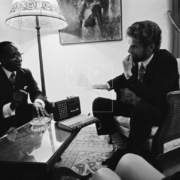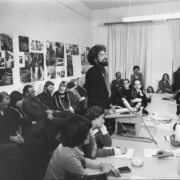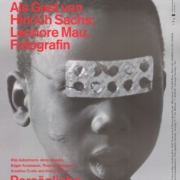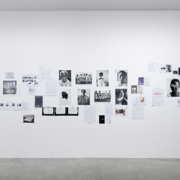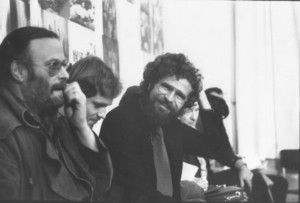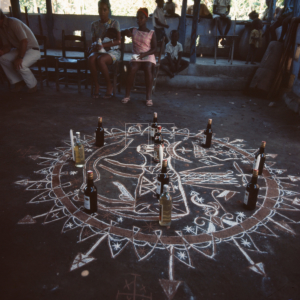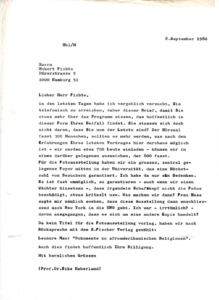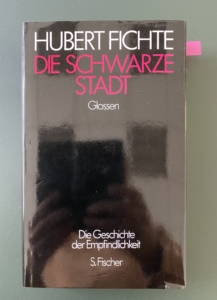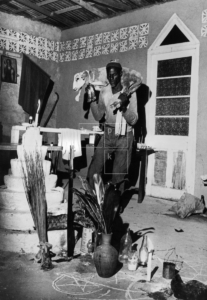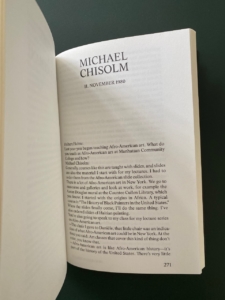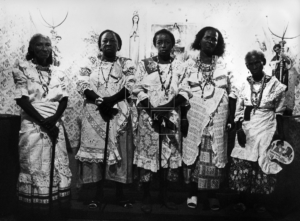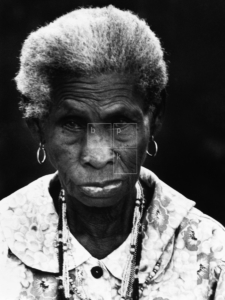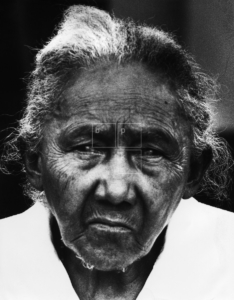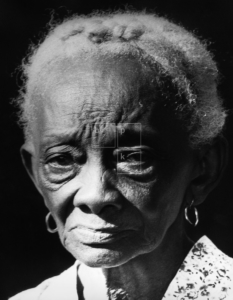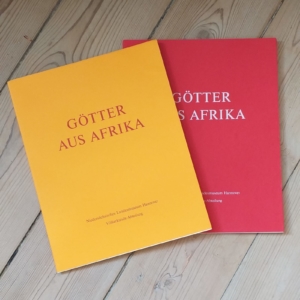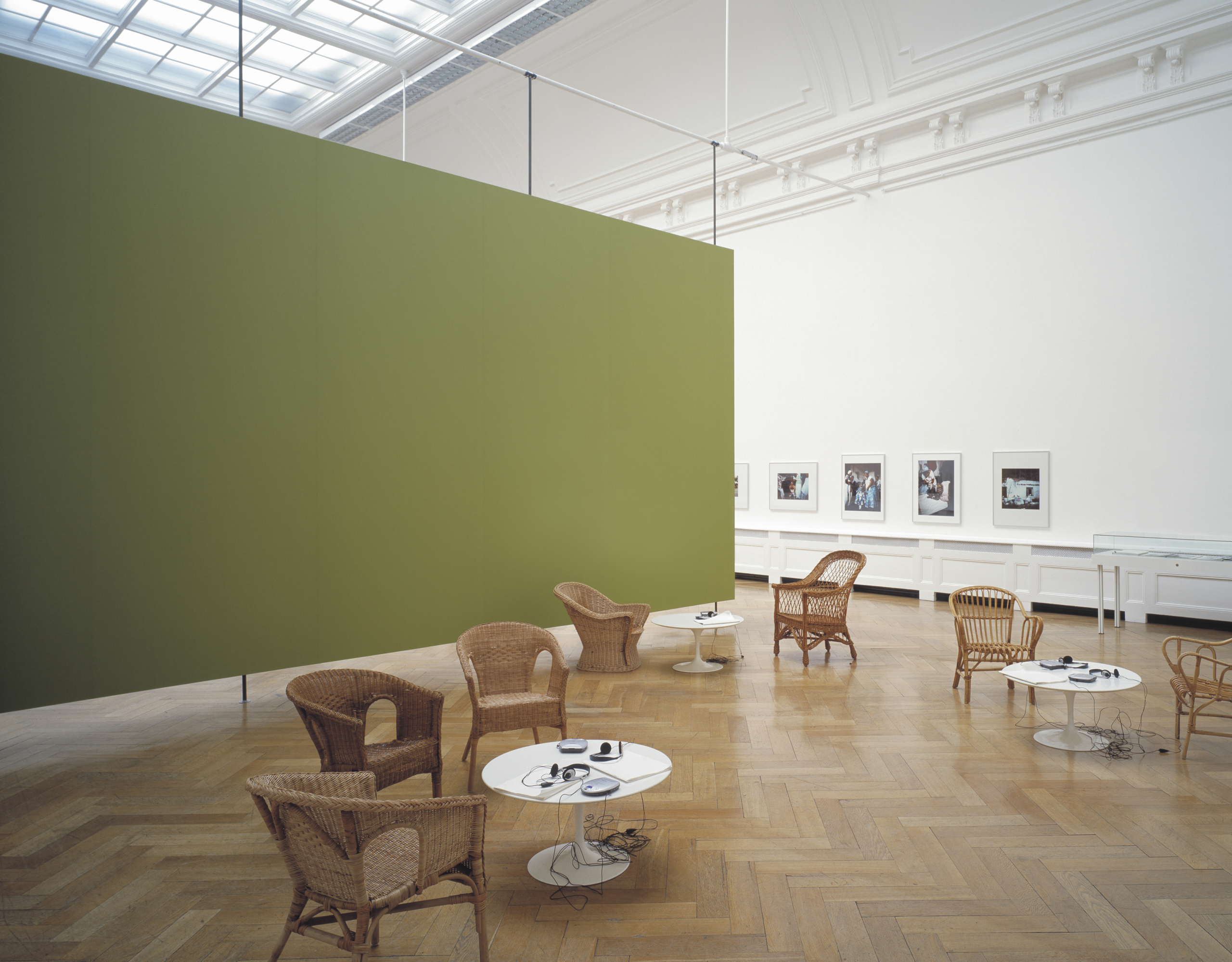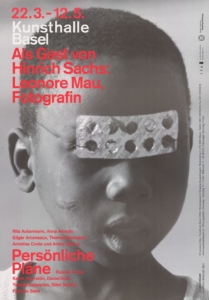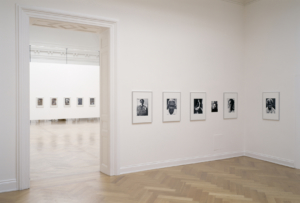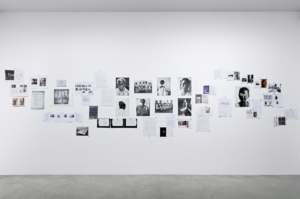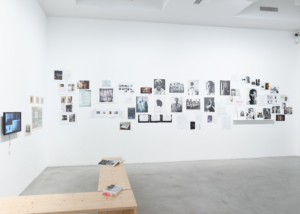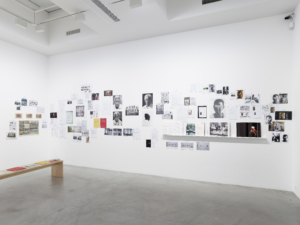Exhibition examples
Exhibition examples, research and text: Mona Schubert
1976/81
[Xango], Institut Fondamental de l’Afrique Noir, Université Cheikh Anta Diop de Dakar, on the occasion of the 70th and 75th birthdays of the former State President of Senegal and poet Léopold Sédar Senghor
The Institut Français d’Afrique Noire (IFAN) was founded in 1936 as part of the “civilising mission” of the French colonial powers. Its purpose was to school administrators in a better understanding of African societies. The newly won cultural awareness acquired through the expansion of educational resources in West Africa turned the IFAN into an incubator for independence movements, such as Négritude. Francophone West African students who campaigned for a diverse and equally entitled Black culture and way of life later emerged as political leaders – as, for example, the Senegalese poet and later, the first post-independence president of Senegal, Léopold Sédar Senghor.
Contact to Senghor came about in 1974 as a result of the subject of Hubert Fichte’s research, interviewing various state leaders in the course of his travels, which in turn was photographically documented by Leonore Mau. In 1976 and 1981, respectively on the occasions of Senghor’s 70th and 75th birthdays, selections of Mau’s photographs from the photo book Xango were shown at the Cheikh Anta Diop University of Dakar, as is documented both in the conference paper Iberoamericana. Literatur Spaniens, Portugals und Lateinamerikas from 1986, and in the special press release on the publication of Petersilie. What remains unclear, however, is precisely which motifs were shown in both these early solo exhibitions, since it has as yet proven impossible to uncover any further archival evidence on this issue, both in the estate of the S. Fischer Foundation and at the Cheikh Anta Diop University of Dakar.
Untitled (Hubert Fichte in an interview with Léopold Sédar Senghor), 1974, © bpk / S. Fischer Stiftung / Leonore Mau
1977
Exhibition accompanying Hubert Fichte’s lecture Ketzerische Bemerkungen für eine neue Wissenschaft vom Menschen, Frobenius Society, Frankfurt am Main, 12 January 1977
Accompanying Hubert Fichte’s lecture Ketzerische Bemerkungen für eine neue Wissenschaft vom Menschen, held on 12 January 1977 at the Frobenius Gesellschaft in Frankfurt am Main, Leonore Mau exhibited works from their collaborative photo book Xango. Die afroamerikanischen Religionen (1976).
The images were not intended as mere illustrations of the lecture but more as an echo to lend visual emphasis to Fichte’s call for a dialogue between scientists and indigenous people, as opposed to the classical academic approach that Fichte called “professorial Rococo”.
In particular during the 1980s and 1990s, the photographs from Xango took centre stage in Mau’s exhibitions. One of the most exhibited motifs from this series is Gläubiger in Trance (Worshipper in a trance) that she took in Trou-du-Nord in Haiti between 1972–1978.
Untitled (Untitled (Hubert Fichte, Ketzerische Bemerkungen für eine neue Wissenschaft vom Menschen lecture at the Frobenius Society in Frankfurt am Main, 12.01.1977; in the background Leonore Mau Xango 1976),
Photographer unknown
From left to right: Peter Michel Ladiges, Claus Deimel, Hubert Fichte; Hubert Fichte, Ketzerische Bemerkungen für eine neue Wissenschaft vom Menschen lecture at the Frobenius Society in Frankfurt am Main, 12.01.1977; in the background Leonore Mau Xango 1976),
Photographer unknown
Untitled (Creditor in a trance), 1972-1978
© bpk / S. Fischer Stiftung / Leonore Mau
Ohne Titel (Vévé), 1972-1975
© bpk / S. Fischer Stiftung / Leonore Mau
Letter to Hubert Fichte from Prof. Dr. Eike Haberland on the status of the planned exhibition Dokumente zu afroamerikanischen Religionen at the Frobenius Institute, 1980
© Frobenius-Institut
On the exhibition Dokumente zu afroamerikanischen Religionen at the Frobenius Institute.
Text by Prof. Dr. Eike Haberland
© Frobenius-Institut
1980
Xango, Countee Cullen Branch Library, Harlem Public Library, New York City, Black Emergency Cultural Coalition Inc., curated by the Black Emergency Cultural Coalition Inc., coordinated by Michael R. Chisolm, 5–29 November 1980
The Black Emergency Cultural Coalition Inc. (BECC) was first organised in 1969 by a group of African-American artists in protest against the exhibition Harlem on My Mind. Cultural Capital of Black America 1900–1968 at the MoMA, which had omitted contributions by African-American painters and sculptors. Among the founding members of this group were several prominent African-American artists such as Benny Andrews and Clifford R. Joseph. The BECC’s foremost concern was to achieve greater representation of African-American artists in New York’s museums and to establish an African-American curatorial presence. As an example of the group’s activity, in 1971 the BECC called for a boycott of the Whitney Museum of Modern Art after discussions collapsed between the group and the museum regarding an exhibition with greater participation and visibility of African-American artists.
Over the years since its inception, the BECC has supported numerous lectures, discussions and panel conversations on a variety of subjects related to the African-American community and art. Among these was also the exhibition Xango, held in 1980 in the Countee Cullen Branch Library in Harlem, New York, in cooperation with the PPS-Galerie and S. Fischer Verlag. On show were images from Leonore Mau’s eponymous photo book and from Petersilie (1980), which documented Black, religious rituals and rites of the African diaspora. At the time, the African-American painter, photographer and art mediator Michael R. Chisolm assumed the coordination of this project and became one of the most important interview partners for Fichte’s novel Die Schwarze Stadt (The Black City). Records from the estate of the BECC reveal that that exhibition was also offered to the American Museum of Natural History, but the museum rejected the proposal. After the exhibition closed it was taken on a tour through Latin America lasting several years, organised by the Goethe-Institut.
Untitled (The Bronx), 1980, © bpk / S. Fischer Stiftung / Leonore Mau
Book cover of the German version Die Schwarze Stadt
© Marlene Burmeister
Untitled (Congo priest with animal sacrifice and altar), 1975
© bpk / S. Fischer Stiftung / Leonore Mau
Untitled (Santería ritual), 1978
© bpk / S. Fischer Stiftung / Leonore Mau
Book cover of the English version The Black City
© Anna Götte
Book page from the English version The Black City
© Anna Götte
1993
Götter aus Afrika, Niedersächsisches Landesmuseum Hannover, Völkerkundeabteilung, Universität Hannover, 19 March–31 May 1993, curated by Dr Claus Deimel, assisted by Ronald Kay
The ethnologist and curator Dr Claus Deimel, who had stood in close professional exchange with Hubert Fichte since the late 1970s, invited Leonore Mau to the Landesmuseum in Hanover to show works from Xango that he had seen in the context of his participation in Fichte’s lecture at the Frobenius Institut in 1977.
Titled Götter aus Afrika, this was Mau’s first large-scale exhibition in an ethnological collection, and the first ethno-poetic exhibition in the German-speaking world to adopt Fichte’s approach. The show was built around a dialogue between Leonore Mau’s photographic images – as reproduced in Xango (1976), Petersilie (1980), and the then still unpublished volume Psyche (released in 2005) – and the works in the collection that included ritual objects from Mali, Liberia, Côte d’Ivoire, Burkina Faso, Ghana, Togo, Benin, Nigeria, Cameroon, Zaire and Haiti.
Accompanying the presentation was a two-part catalogue, divided between photographs and objects. The Chilean author – a longstanding friend of Mau and Fichte, and married to Pina Bausch – was involved in the exhibition’s hanging and the edition of the two-part catalogue. In 2006, Kay was also partly responsible for the publication of the final volume of photographs by Mau and Fichte, Die Kinder Herodots, in 2006.
Exhibition view, 1993, © Landesmuseum Hannover
Untitled (Priestesses of the temple Casa das Minas), 1981/82
© bpk / S. Fischer Stiftung / Leonore Mau
Untitled (Priestess Dona Luiza ), 1981/82
© bpk / S. Fischer Stiftung / Leonore Mau
Untitled (Priestess Dona Juana), 1981/82
© bpk / S. Fischer Stiftung / Leonore Mau
Untitled (Priestess Dona Flora), 1981/82
© bpk / S. Fischer Stiftung / Leonore Mau
Exhibition catalogues for “Götter aus Afrika”
© Marlene Burmeister
2002
Als Gast von Hinrich Sachs: Leonore Mau, Fotografin, Kunsthalle Basel, 23 March–12 May 2002, curated by Hinrich Sachs
In 2002 the artist and curator Hinrich Sachs invited Leonore Mau, now 86 years old, to hold an exhibition in the Kunsthalle Basel.
This was not only Leonore Mau’s first solo exhibition in the context of a major art institution, but for the first time it also presented an edition of her works published in newspapers and magazines. One part of her exhibition was also the portfolio work Grosse Anatomie from 1977, which due to its sensitive content was shown in a small gallery, deliberately set apart from the main exhibition.
In Basel Leonore Mau was granted greater participation in the curatorial process: thus it was her choice, for instance, to place a portrait of Hubert Fichte, her companion in life and work, in the midst of the series of Priesterinnen.
Exhibition view Als Gast von Hinrich Sachs: Leonore Mau, Fotografin, Kunsthalle Basel, 2002, Photo: Serge Hasenböhler.
Courtesy Kunsthalle Basel / Serge Hasenböhler
Poster of the exhibition Als Gast von
Hinrich Sachs: Leonore Mau, Fotografin,
Kunsthalle Basel, 2002.
Graphic: Urs Graf, Gregory Vines
© Plakatsammlung SfG Basel
Reprint of selected journal articles by Leonore Mau
© Hinrich Sachs
Exhibition view Als Gast von Hinrich Sachs: Leonore Mau, Fotografin, Kunsthalle Basel, 2002.
Photo: Serge Hasenböhler.
Courtesy Kunsthalle Basel / Serge Hasenböhler
Hubert Fichte, 1970
© bpk / S. Fischer Stiftung / Leonore Mau
Hall text for the exhibition Als Gast von Hinrich Sachs: Leonore Mau. Fotografin
© Kunsthalle Basel
2020/2021
SITUATION #200: Case study from the collection of the Fotomuseum Winterthur on the works of Leonore Mau, SITUATIONS/The Right to Look, Fotomuseum Winterthur, 29 February 2020–14 February 2021, curated by Dr Doris Gassert and Mona Schubert
As part of the experimental exhibition and research format SITUATIONS (2015–2021), the curatorial team of the Fotomuseum Winterthur presented works by Leonore Mau to address the question of how the museum might approach its own collection from a postcolonial perspective. Named after a term coined by Nicholas Mirzoeff , the cluster titled The Right to Look focused on artistic, cultural and curatorial strategies that lay bare, critically challenge, intersect and redefine the power dynamics of the gaze. Central focus of the case study performed in this setting was initially the provenance of the two series Grosse Anatomie (1977) and Priesterinnen (1990), in addition to the single photograph titled Afrikanischer Junge mit Blistermaske (African Boy with Blister Mask; 1974). In a rearrangement of the exhibition in June 2020, in consultation with Hinrich Sachs the focus was shifted onto the publication contexts relative to the photo books Xango (1976), Petersilie (1980) and Psyche (2005), as well as to the magazines and newspapers, for which a reprint of the prints accompanying Mau’s publications was purchased by Hinrich Sachs. In addition, the display was supplemented by a further cycle of photographs, Die Mauerbilder des Papisto Boy in Dakar (The Murals of Papisto Boy in Dakar; 1980). In the final re-hanging of the exhibition in September 2020, the way these images circulated in exhibitions and between art museums and ethnological collections was outlined in a series of installations views and accompanying publications.
Supplementing the shifting display within the exhibition space in which research material was hung directly alongside the works, a number of interviews with exhibition curators and close friends of Leonore Mau was compiled and made accessible both on a screen in the exhibition and online. Thus Case Study#200 provided an independent counterpart to the research and exhibition project, which focused largely on Hubert Fichte, titled Hubert Fichte: Liebe und Ethnologie (Hubert Fichte: Love and Ethnology), that was staged in 2017–2020 in the Haus der Kulturen der Welt in Berlin.
Dr. Claus Deimel in an interview.
Case Study from the collection Fotomuseum Winterthur on the works of Leonore Mau, 2020, © Fotomuseum Winterthur
1_February_2020
Case Study from the collection Fotomuseum Winterthur
on the works of Leonore Mau,
SITUATION #200, SITUATIONS/The Right to Look,
Exhibition View Fotomuseum Winterthur, February 2020
© Philipp Ottendörfer
2_June_2020
Case Study from the collection Fotomuseum Winterthur
on the works of Leonore Mau,
SITUATION #200, SITUATIONS/The Right to Look,
Exhibition view Fotomuseum Winterthur, June 2020
© Benedikt Redmann
3_October_2020
Case Study from the collection Fotomuseum Winterthur
on the works of Leonore Mau,
SITUATION #200, SITUATIONS/The Right to Look,
Exhibition view Fotomuseum Winterthur, October 2020
© Benedikt Redmann

